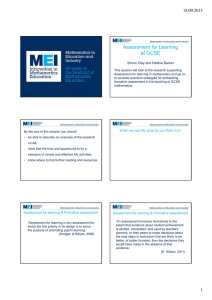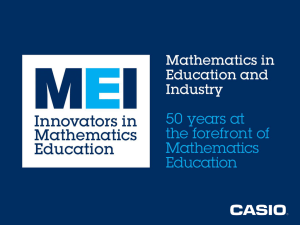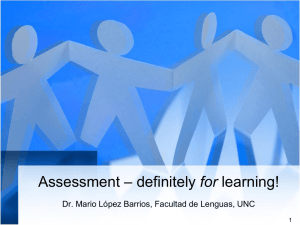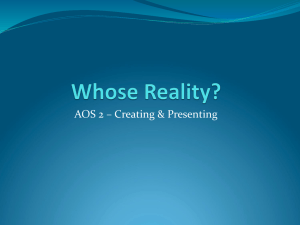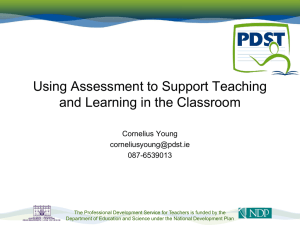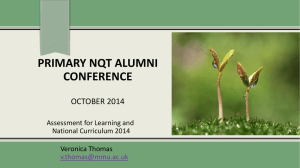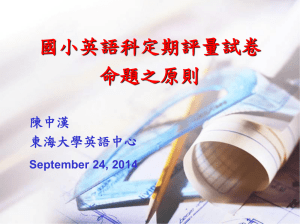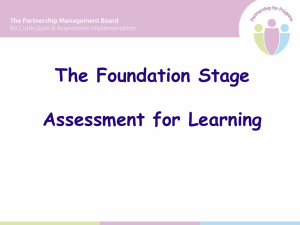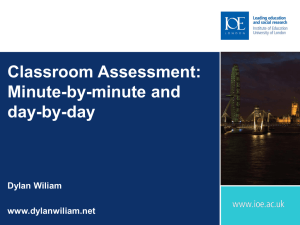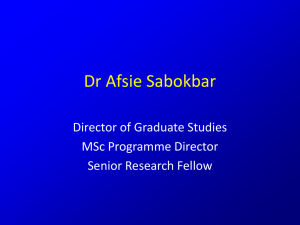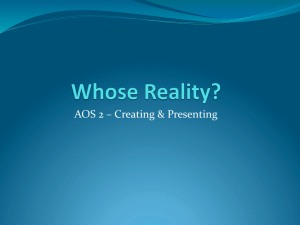Assessment : Enhancing Teaching and Learning in the
advertisement
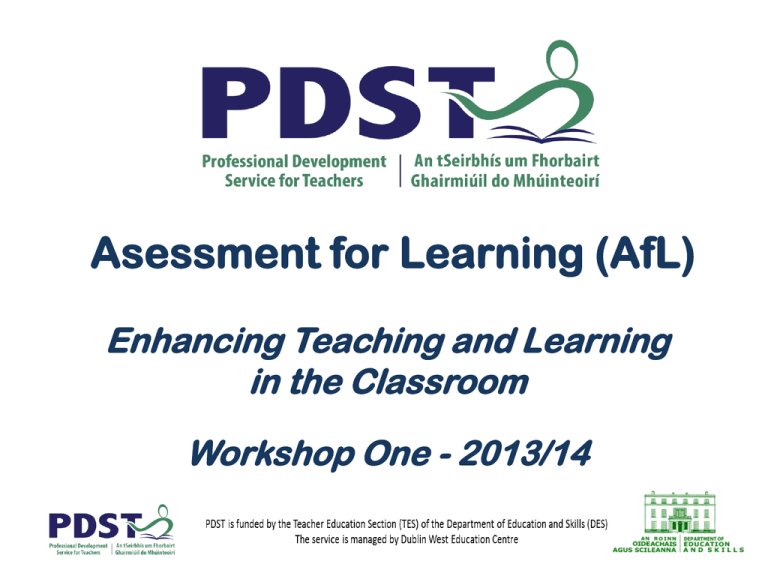
Asessment for Learning (AfL) Enhancing Teaching and Learning in the Classroom Workshop One - 2013/14 Key Messages • Assessment is at the heart of effective teaching and learning • Assessment information is used to identify learning needs and adjust teaching • Three interrelated and complementary approaches support student achievement: Assessment of learning Assessment for learning Assessment as learning Learning Outcome: Enable participants to use assessment to enhance teaching and learning in the classroom. Success Criteria: Define assessment Distinguish assessment of, for and as learning Know the key elements of assessment for learning Write learning outcomes Suggest activities/tasks to achieve the learning outcomes Devise success criteria Focus on effective feedback Defining Assessment “Assessment in education is about gathering, interpreting and using information about the processes and outcomes of learning”. “It takes different forms and can be used in a variety of ways...” Assessment in the Primary School Curriculum – Guidelines for Schools. NCCA 2007 p.7 http://www.juniorcycle.ie/About.aspx School Self Evaluation (SSE) The SSE Guidelines recommend that schools: • Use a range of assessment methods – not just those linked to state exams • Involve students in the assessment of their work • Monitor and correct students work • Provide constructive feedback to students. • Use assessment information to inform planning • Have a written policy on assessment Continuum of assessment NCCA, 2007 Learning Outcome: Enable participants to use assessment to enhance teaching and learning in the classroom. Success Criteria: Define assessment Distinguish assessment of, for and as learning Know the key elements of assessment for learning Write learning outcomes Suggest activities/tasks to achieve the learning outcomes Devise success criteria Focus on effective feedback Assessment OF Learning (Summative) Happens after learning takes place Information is gathered by teacher Information is usually transferred into marks Comparison with performance of others Looks back on past learning Assessment FOR Learning (Formative) An integral part of learning process Information is shared with learner Information is available on quality of learning Is linked to learning outcomes and success criteria Looks forward to the next stage of learning 10 Reflect on Current Practice Assessment of and for learning..... Source: “Putting Assessment for Learning into Practice,” David Spendlove, 2009) Assessment for Learning (formative) is not an attack on assessment of learning (summative assessment). These are complementary approaches - it’s about getting the balance right. It is the teacher who decides the balance and timing of formative and summative assessments; (“Putting Assessment for Learning into Practice,” David Spendlove, 2009) Assessment for Learning (AfL) Enables teachers and students to focus on three key questions 1. Where are students now in their learning? 2. Where are students going in their learning? 3. How will students get to the next point in their learning? NCCA Assessment Guidelines p9. Assessment for Learning: Key Elements 1. 2. 3. 4. 5. Learning Outcomes and Success Criteria Effective Feedback Effective Questioning Self assessment - Students as owners of their own learning Peer Assessment - Students as Instructional resources for each other Assessment for learning strategies need to be phased into practice over time. AfL Assessment for Learning – A Practical Guide 2010 p38 Junior Cycle Framework Key Skills • Literacy • Numeracy Learning Outcomes • Learning Outcomes are an explicit description of what a learner should know, understand and be able to do as a result of learning. (Learning and Teaching Institute, Sheffield Hallam University) Learning Outcomes We Are Learning To – Write a letter/report – Design an experiment – Add fractions with mixed numbers Learning Outcomes “Lessons are guided by syllabus-linked learning outcomes that are shared with the students.” SSE Guidelines • Example: Students will be able to: Plan a balanced breakfast menu for two Demonstrate understanding of the concept of plate tectonics Explain how the respiratory system works. Devising Learning Outcomes • State learning outcomes simply and clearly. • Learning Outcomes should be capable of being validly assessed – a verb should be used in the statement. Plan a balanced breakfast menu for two Demonstrate understanding of the concept of plate tectonics Describe the environmental effects of a natural disaster Separating the Learning Outcome from the Context of Learning The context of learning is simply the actions, activities and/or tasks students will be doing to achieve the Learning Outcome. Learning Outcome Context of Learning Write clear instructions How to bake a cake Present an argument for or against a controversial proposition Identify metaphors Four corner discussion on the statement, “student benefit should be reduced” Lake Isle of Inisfree Identify the parts of an organ Dissection of heart Separating the Learning Outcome from the Context of Learning The context of learning is simply the actions, activities and/or tasks students will be doing to achieve the Learning Outcome. Learning Outcome Context of Learning Demonstrate a good general Study of Greek and Roman knowledge of, and an civilisation appreciation for, the uniqueness of each age and civilisation (K,A) If the learning outcome is free of context it can illustrate to students that there are many reasons for learning the concept Learning Outcome with Context What students thought they were learning Learning Outcome without Context What students thought they were learning now To write instructions to make a sandwich “I would learn how to make a sandwich” To write instructions “We would be learning how to write instructions” To know why Samuel Pepys is important in understanding the events of the Great Fire of London “We would be learning about what happened and what he wrote. We would also learn how to put a fire out.” To know how primary sources help us to find out about the past “We would learn how other people lived in previous centuries.” From Clarke, S. (2005) Formative Assessment in Action: Weaving the elements together http://www.youtube.com/ watch?v=qw-Efx6gj-U Workshop Activity Use the subject-based statements on the worksheet to: 1. Write a clear learning outcome 2. Identify a context of learning (task/activity/teaching approach etc.) Learning Outcome Context of Learning Identify metaphors Lake Isle of Innisfree. Key skills Success Criteria Success Criteria suggest ways to achieve a learning outcome. “How will I know when I have learned?” “How will I know when I have achieved the learning outcome?” The learning outcome and the success criteria need to be visually displayed –WILF - What I’m Looking For Success criteria can be • • • • a series of steps/sequence of instructions a list of options/menu from which the students can choose a list of “remember to” prompts a visual aide memoir Success Criteria – menu/list of options • Learning Outcome: Create a written character portrait • What will you need to do to achieve this? (Success Criteria) Include some or all of the following • Appearance • Hobbies and interests • Personality traits • Attitude to self/others • Occupation • How others respond to the character..... Success Criteria – “remember to” prompts • We are learning to : Make a Clear Poster • Success Criteria – Remember to: Make all your letters the same size Use dark colours Don’t use yellow Put pictures around the edge not the middle Check that you have copied all the words and dates correctly http://www.youtube.com/watch?v=ihFLnNJeV90 Writing Success Criteria THINK - What are the elements of the topic I’m going to teach? Example Learning Outcome Describe the environmental effects of earthquakes Success Criteria State one effect on each of the following: • Human Life • Man Made Structures • The Natural Environment 1st Year Business Studies: Syllabus Link: Enterprise: Transportation and Delivery Systems; Factors affecting choice of delivery systems Learning Outcomes Students will be able to evaluate the main types of transportation which are suitable for transporting goods Context of Learning In pairs, students will write a report for a company involved in selling goods abroad, advising them of the best method of transporting their goods abroad. Success Criteria Present a report that will: Explain the four main types of transport (road, rail, sea and air) Explain the factors that a company should take into account when choosing a suitable form of transport Recommend a method of transporting goods abroad 3rd Year History. Syllabus link: Understanding the modern world; International History in the 20th C; Nazi Germany Learning Outcomes Students will be able to evaluate the role of women in Nazi society Context of Learning Describe in detail, in diary form, the lifestyle of a woman in Nazi Germany Success Criteria Students will be able to: identify the role of women in Nazi society Discuss the changes that have taken place in the lifestyle of women as a result of Hitler’s rule Workshop Activity Write success criteria for the learning outcomes previously identified! Learning Outcome Context of Learning Success Criteria Effective Feedback “Feedback is among the most powerful moderators of learning” Hattie, 2012 Effective feedback • Oral – most powerful impact • Marks/grading only- does little to improve learning • Written comment - quality more important than frequency Principles of Effective Feedback • • • • Involves more work for receiver than the giver Timely Clear and focused Attached to the learning outcomes and success criteria • Concrete, specific and useful; therefore it is actionable. Can a student take action to the following examples of feedback? “Good job!”, “B+”, “I’m so pleased with your essay!” • User friendly: understandable language; concentrate on one or two key elements of performance • Too much feedback can be counter-productive • Ongoing!! Feedback only works formatively if the student has opportunity to improve to better achieve the learning outcome. In summative assessment the feedback is too late. Effective Feedback Techniques • Three Questions: asking the students to reflect on their work and move it forward • Spot your own mistake Marking Work Success and Improvement • Underline/put a star beside/highlight/ remark on the two best aspects of the work. • Indicate where an improvement could be made (the ‘wish’) • Should be done against the learning outcome and/or success criteria. ‘Closing the gap’ prompts • A reminder Prompt (e.g. use more adverbs and adjectives here. ) • A scaffolded prompt (e.g. Use some adverbs to describe how he fought. Jason tried_________ to distract him but the dragon ______ly used his strength to get past. Jason stabbed his sword _______ly into the dragon’s nearest side. • An example prompt –Give two examples and ask student to “improve the fight by using one of these or your own” ‘Closing the gap’ prompts • A reminder Prompt (e.g. use a quote to back up your opinion ) • A scaffolded prompt (e.g. Use some adverbs to describe how he fought. Hector tried_________ to distract him but Achilles ______ly used his strength to get past. Achilles stabbed his sword _______ly into Hector’s body. • An example prompt –Give two examples and ask student to improve their opinion by using one of these or your own Feedback vs Advice • Feedback must be linked to the learning outcome and success criteria as well as moving the learning forward, otherwise it tends to become either a judgement or advice. • Can you spot the difference? You need more examples in your report I’d like you to find two other quotes to support your argument. I really enjoyed reading your short story Good job: B+ Feedback using Learning Outcomes and Success Criteria • Learning Outcome – Design a tourist brochure • Context – choose your own/assigned • Success Criteria – Include – A map(s) showing the location of at least five famous tourist attractions – Interesting and relevant information – Pictures/drawings – Brochure clear and well laid out • Feedback – oral/written using the LO &SC Assessing Progress During Lessons Asking key questions: • • • • to measure student progress in learning orally to generate class discussion use open questions higher order questions Strategies for Effective Questioning • Use ‘open’ rather than ‘closed’ questions – E.g. Is Iago or Othello responsible for Othello’s downfall? Strategies for Effective Questioning • Change the question into a statement: Instead of asking: “Who was most responsible for the Irish Civil War?” Make a statement: “DeValera was responsible for the Irish Civil War.” Strategies for Effective Questioning • Invert the question e.g.: “Is Ireland a republic?” Change to: “What does it mean for a country to become a republic?” • Insert the word “might” into the question “What is the meaning of socialism?” “What might be the meaning of socialism?” Strategies for Effective Questioning Start your questions with “why” or “how” Instead of asking: “What is a prime number?” Ask: “Why is 7 a prime number and 9 a composite number? Instead of asking: “What was life like under the Taliban?” Ask: “How were the lives of men and women different under the Taliban?” Assessment It is essential that teachers ensure that AfL does not become a set of teaching tips that ultimately fall into unthinking routines of traffic lights, two stars, WALT boards, success criteria and so on. AfL – A Practical Guide (N. I Curriculum) pii For Next Time Plan and teach lesson to include: • • • • Sharing learning outcomes with students Agreeing success criteria with students, and the Provision of effective written/oral feedback If possible, note one or two questions that generated dynamic class discussion
